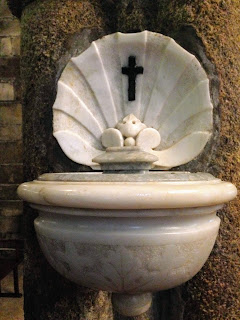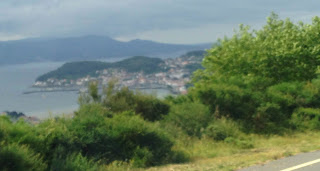Stayed my first night in Santiago in a large, modern, impersonal hotel about 30 minutes walk from the town centre (But it did have scrambled eggs available on the breakfast buffet, which were tasty).
Was booked for the next two nights to stay in a private room in an Airbnb apartment very centrally located only 3 minutes walk from the Cathedral.
So that first morning I walked in to town and left my red bag at the apartment before I left on the bus trip to Finisterre and Muxia.
The lady who owned the third floor apartment was charming and welcoming, and I really enjoyed my stay there. It was on the 3rd floor with a tiny balcony looking over stonewalled back yards to wooded hills at the edge of the city.
The bus for the Finisterre tour was modern and high, affording good views, especially as I managed to score a front row seat. The lady beside me, Maria, was a cardiac research nurse specialist from Mexico who had reasonable English, so we had interesting conversations. The guide, Mario, was an English speaking Spaniard, with good knowledge of all the sites we visited.
As we left Santiago he suggested we look back to see the spires of the cathedral, which are very high. No building can be constructed in Santiago which is higher than those spires. 600,000 pilgrims arrived on the various Caminos last year to Masses at the Cathedral, and to view them.
As we left Santiago he suggested we look back to see the spires of the cathedral, which are very high. No building can be constructed in Santiago which is higher than those spires. 600,000 pilgrims arrived on the various Caminos last year to Masses at the Cathedral, and to view them.
First stop was at a small village named Ames, which had a very old stone bridge, Puente Meceira, a wide weir on the river and one of the oldest Oreos (that is the correct name for the grain storage granaries - it isn't the biscuits!) in Spain. Quaint small village.
 |
| Elegant windmills |
As we approached Carmota, there were numerous windmill farms, similar to ours just north of Wellington, and soon after we had our first view of the coast and Atlantic Ocean.
 |
| Holy Water font |
Stopped at Muros, a seaside village on a slope running down to the sea. Climbed up the hill to visit the church of St Mary in the Field. The interior of the church resembles the inverted keel of a boat. It symbolises the spirituality of a congregation tied to the sea.
The baptismal font has a coiled marble snake in it. Legend has it that because babies are born with original sin, the snake purifies the holy water before they are baptised in it.
 |
| Baptismal font with coiled snal |
The baptismal font has a coiled marble snake in it. Legend has it that because babies are born with original sin, the snake purifies the holy water before they are baptised in it.
 |
| St Anthony & baby Jesus |
Way out in the harbour were mussel farms. I mentioned earlier that I was surprised to see stands of eucalyptus trees along The Way as we wlked across Spain. We were told that they were introduced from Australia in the 1800s and planted for their fast growing properties. It is they which are used for the mussel farm (3,000) and oyster(500) platforms. The gums are also used for paper and pulp.
 |
| At Ezaro waterfall |

 |
| Impressive rock face |


Finisterre is said to be where the stone boat carrying St James casket berthed. Legend has it that a large shaped stone on the shore is part of the original hull. Beats me how it would float, but who knows. Miracles do happen!



All pilgims who walk the Camino collect stamps in their Pilgrim's Passport along The Way. I got mine from wherever I stayed, and either a church I went to or some other place of interest. When I went back to the central city at 6.50pm, I lined up at the Pilgrims Office to collect my Compostella, a certificate in Latin, which pilgrims who have completed at least 100Km on foot, or 200kms on a cycle, are entitled to. I was fortunate that the queue at that time was short, and I walked out with mine 30 minutes later.
I had talked to others who had waited over three hours earlier in the day.
The next day I enjoyed exploring Santiago de Compostela. First stop was an English language Mass in a chapel at the cathedral. Celebrated by a tall red headed and bearded Irishman, he started by suggesting we go around, say our name,where we we from, and where we started our Camino. So that was interesting. I was the only Kiwi, but there were two Aussies. Lovely Mass. Nice way to start the day. I then had a good look around the cathedral, which is very lavish in some of the side chapels, and especially around the main altar. There is a huge statue of Saint James behind the main altar, and pilgrims may walk up a flight of stairs behind him to place hands on his shoulders and venerate him.
Not knowing about the stairs at that time, it was a bit disconcerting to see hands suddenly appear on this high statues shoulders during the midday Mass the day I arrived.
As you will see in the photos, one of the main towers at the north entrance has scaffolding all around it while the stonework undergoes cleaning. So while that is happening the main entrance is closed also, so we couldn't see all of its frescoes and features. The cathedral has had several predecessors, the first being erected over St James tomb. The present one was started in 1073, and took 100 years to build. The workmanship is impressive, especially when they had none of the modern cranes etc used for today's constructions.
I then looked at art galleries, museums, and other ancient churches. My favourite place was the Galician Historic Museum. It had a huge collection of old artefacts, tools, clothes, books etc, and had detailed displays and descriptions of how they had been used in former times. Some were: blacksmith's forge, bootmaker's shop, and a classroom with slates on the old desks. I walked around Santiago looking up around the top of the historic buildings, which had some very detailed pediments, towers and effigies.
Pilgrimage is an archetypical experience, which means it calls to people across time and traditions. Whether we make an inward or outward journey, pilgrimage is essentially a series of practices for being fully present to life in the midst of joy and struggle. These practices help to cultivate freedom within to respond to God's calling.
~ Christine Valters Paintner






















































